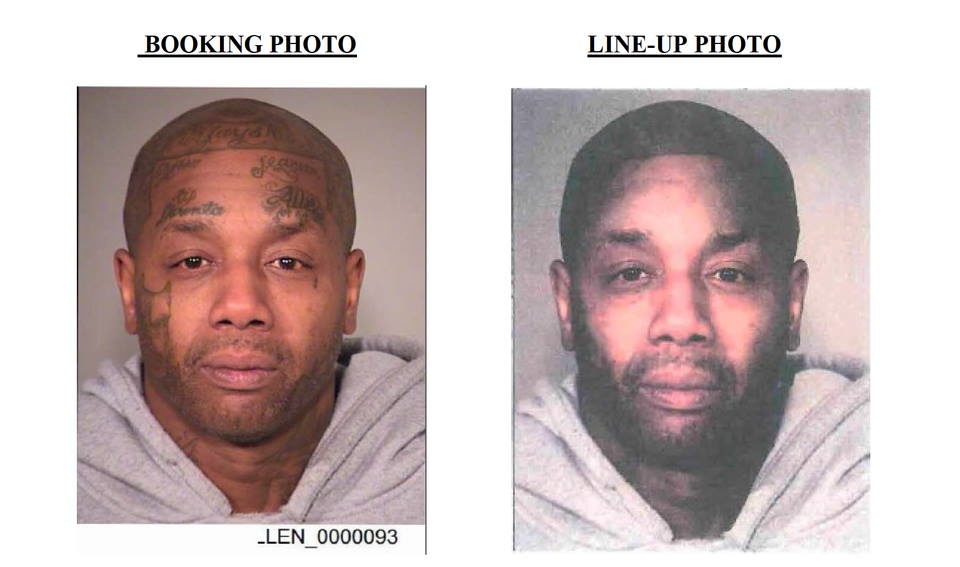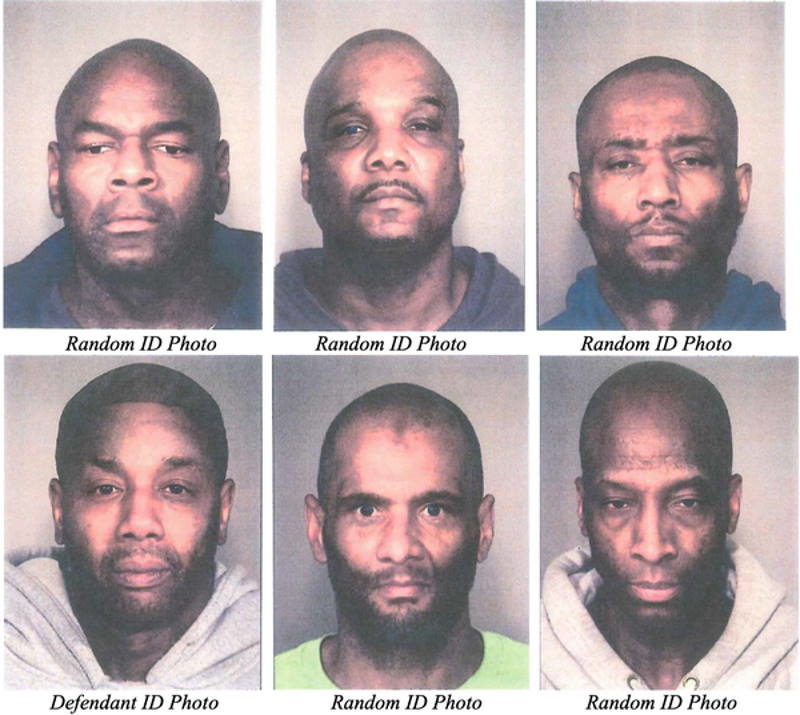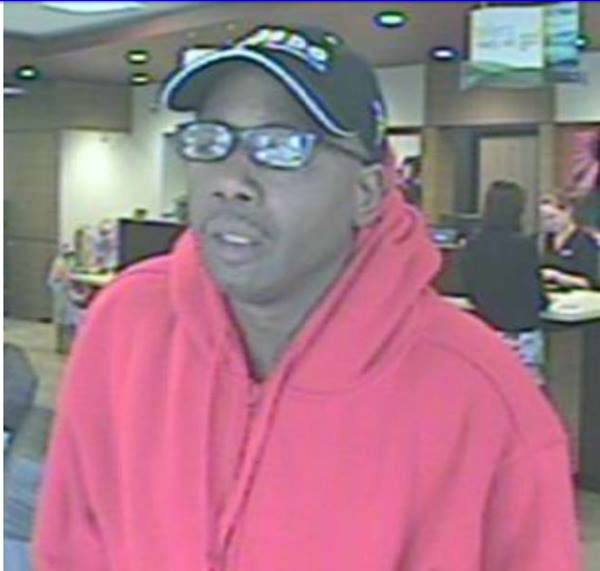
But when Portland police suspected Allen was involved in four bank and credit union heists, and none of the tellers reported seeing tattoos on the face of the man who robbed them, police digitally altered Allen's mugshot.
They covered up every one of his tattoos using Photoshop.
"I basically painted over the tattoos,'' police forensic criminalist Mark Weber testified. "Almost like applying electronic makeup.''
Police then presented the altered image of Allen with photos of five similar-looking men to the tellers for identification. They didn't tell anyone that they'd changed Allen's photo.
Some of the tellers picked out Allen.
The practice came under fire this week in a federal courtroom in Portland as Allen's attorney argued that the manipulation allowed police to "rig the outcome" of the photo lineup.
The standard law enforcement tool is under ongoing scrutiny. This example floored Jules Epstein, a law professor at Temple University and leading national authority on eyewitness testimony.
In his 40 years as a lawyer and law professor, Epstein said he's never heard of something so blatantly suggestive.
"It's unbelievable to me that police would ignore the fact that no teller has described a person with glaring tattoos and make this man into a possible suspect by covering them up," he said. "They're increasing the risk of mistaken identity.''
Mistaken eyewitness identifications remain a consistent thorn in the criminal justice system's side. They have contributed to about 71% of the more than 360 wrongful convictions in the United States overturned by post-conviction DNA evidence, according to the Innocence Project.
Both the U.S. Supreme Court and the Oregon Supreme Court have weighed in with rulings on police use of the photo arrays because of the consistent problem.
The U.S. Department of Justice and other law enforcement agencies also have adopted standard protocols of how to handle the arrays to lower the chance of influencing a witness, even unintentionally.
The failure of Portland police to document the photo changes runs counter to the federal guidelines.
Defense attorney Mark Ahlemeyer urged a judge to throw out the positive witness identifications of Allen, saying police clearly wanted the photo without tattoos to more closely resemble the face of their suspect.
"This is a very, very slippery slope given the advent of technology,'' Ahlemeyer said. "We don't know where this may end.''
Assistant U.S. Attorney Paul Maloney defended police actions.
"The whole idea was to make Mr. Allen blend in - so his photo wouldn't stand out,'' he said. "These procedures were prudent. They were appropriate.''
Maloney said the altering of Allen's photo was done to "look like the disguises that were on the robber,'' who wore a baseball-style hat and glasses, with no tattoos visible.
How U.S. District Judge Marco A. Hernandez rules in this case could set precedent on police practices for future cases in Oregon and beyond, though it may ultimately end up before an appellate court, said Steve Kanter, a retired law professor and dean emeritus at Lewis & Clark Law School.
"The touchstone is trying to have the most reliable procedure so you reduce the likelihood or risk of error,'' Kanter said.
Fabrication or 'newly-evolving science'
Allen, 50, was charged in the four bank and credit union robberies, all occurring within a four-day period in early April 2017. The robber threatened he had a gun and demanded money in each, whispering to one teller, "I'll blow your brains out,'' a police affidavit says. If it's the same man who hit each bank and credit union, he made off with just over $14,100 collectively, according to investigators.
It was Allen's attorney who discovered that his client's mugshot had been altered.
When federal prosecutors shared their evidence with Ahlemeyer, nothing in any police reports documented the changes made to the photo.
But Ahlemeyer quickly spotted the unusual photo of Allen in the police photo array and knew it looked starkly different from his client.

The defense attorney filed a motion to throw out the witness identifications.
Police explained in court what they did.
The order to remove the tattoos came from Detective Brett Hawkinson, a nearly 18-year Police Bureau veteran assigned to the FBI's task force on bank robberies and the lead investigator on the case.
Police had previously released a surveillance image of the robber from one of the banks. It didn't show any tattoos on the robber's face. The robber wore a baseball cap and black-rimmed glasses.
After the image was on the news, Hawkinson said police received information from two sources who suggested that Allen fit the robber's description and the image released. By then, Allen was in custody on unrelated warrants after a traffic stop.
Allen could have used makeup to cover up his tattoos, Hawkinson said. One of his objectives, he said, was to rule Allen in or out as a suspect and determine whether the sources who contacted police were credible.
Another officer who didn't know which picture was of the suspected robber presented the manipulated photo of Allen and photos of other men to the tellers in what's called a double-blind photo lineup. The officer presented each photo one by one in a manila envelope to a teller in a sequence.
Both practices are considered among the best protocols to avoid undue "suggestibility'' or influence by police in an eyewitness identification, Hawkinson testified.
Ahlemeyer, on cross-examination, asked if any of the protocols instruct police that they can alter someone's photo.
Hawkinson said no, but quickly added nothing tells police that they can't change an image either. He said he learned of the practice through "on the job training'' and from police supervisors.
It's "standard practice among investigators,'' he said.
"There are times it has been appropriate to make those small subtle changes,'' he added. "The main purpose is not to make the suspect stand out.''
It was better to remove Allen's tattoos from the lineup photo, he said, because they could be too distracting for witnesses. "The purpose of any alteration is not to change the physical attributes but to mask things that would stand out," he said.
"You don't consider tattoos to be physical attributes?'' the defense lawyer asked.
Hawkinson replied that tattoos could be added or removed.
The detective also said removing Allen's tattoos actually could work in Allen's favor, without providing any explanation.
Ahlemeyer seemed perplexed, "Do you think it was in defendant's favor?''
"It is hard to fathom any photo array conduct that is more 'suggestive' than altering a source photograph for the sole purpose of making the investigation target look more like the perpetrator,'' Ahlmeyer told the court.
The detective called the digital manipulations part of "newly evolving science'' in 2017. He said the presence of the altered photo in the evidence file in the case served as documentation.
"I've very concerned about the detective's view about this so-called cutting edge 2017 technology, when there's no protocol to support it,'' Ahlemeyer said.
Tattoos gone, skin tone changed
Weber, the forensic criminalist who did the photo modification, said he used a Photoshop sampling color tool to match the skin tone next to Allen's tattoos and went back over the parts of his face tattooed with a light brush.
The doctored photo appears to make Allen's skin tone on the top of his head darker than his original photo, while his cheeks appear lighter, his lawyer noted.
But the court may never know what exact changes were made to the photo because nothing was documented, Ahlemeyer said.
Weber testified that he didn't write a report because it wasn't part of the Police Bureau's standard operating procedures. He also acknowledged that he had changed suspect photos for other lineups before but wasn't aware of any bureau protocol that expressly allowed that.
Acting Lt. Brad Yakots, a police spokesman, said the bureau "does not create suggestive lineups" and the decision to cover up Allen's tattoos was done in this case to "prevent misidentifying the suspect." He confirmed the bureau has no directive requiring an officer or forensic criminalist to write a report about photo alterations.
The nation's high court has instructed judges to examine whether police identification procedures are unnecessarily suggestive and assess if an identification is reliable based on several factors, such as the extent of a witness's opportunity to view the offender.
In a landmark ruling in 2012, the Oregon Supreme Court unanimously set a stricter standard for eyewitness identification evidence and shifted the burden to prosecutors to establish that the evidence is reliable and admissible in court. The court also noted that judges should independently assess the reliability of eyewitnesses.
In January 2017, months before Allen's arrest, the U.S. Justice Department adopted new rules for agents with the FBI and other federal law enforcement agencies on handling eyewitness identification and photo throw-downs.
When a suspect has a unique feature such as a scar or tattoo, agents should find so-called "filler" photos of people with a similar feature. If they can't duplicate a suspect's unique feature, then they can black it out and place a similar black mark on the other "filler" photos.
In any case, the guidelines say, any alterations to photos should be documented, as well as the reasons for doing so.
Judge Hernandez heard the arguments and said he plans to issue a written ruling soon.
Maxine Bernstein has been a staff writer with The Oregonian since 1998, and covers crime, Portland police and federal court. Email at mbernstein@oregonian.com Follow on Twitter @maxoregonian




Look closely at the surveillance photo image and compare it to either photo of Mr. Allen - setting aside tattoos and makeup, those individuals do NOT look similar in any way. The facial structure of each individual is significantly different from the other.
This is also why facial recognition is being withdrawn and banned - since it has been developed by Caucasians who have had little or no exposure to African Americans or others, the software consistently mis-identifies African Americans and others because, just like the developers, the software falsely assumes that all African Americans look alike.